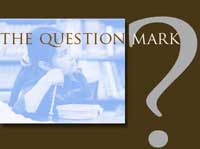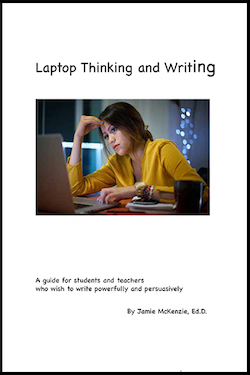Order Jamie's books online with Paypal or a credit card

|
Vol 18|No 2| December|2021
|
|
"Why?" I have long argued, is the four-year-old's favorite question. This belief was formed when my own daughters were four-year-olds and I was teaching that age group in Sunday School back in the 1970s. At the same time, I was an elementary principal in New Jersey, and I became fascinated by student questions and questioning - seeds of thought that eventually led to the creation of this journal.
In 1997 I published an article in my FNO journal, "The question is the answer" in which I asserted that "why?" was one of three "prime questions" that enabled most important thinking. A quarter of a century later, it seems to me those words (reproduced below) still ring true.
Why?
Why do things happen the way they do?
This question requires analysis of cause-and-effect and the relationship between variables. It leads naturally to problem-solving (the How question) or to decision-making (the Which is best? question).
Why? is the favorite question of four-year-olds. It is the basic tool for figuring stuff out (constructivist learning). At one point while researching student questions in one school district, I found Why? occurred most often in kindergarten classrooms and least often in the high school (which had the highest SAT scores in the state.)
Why does the sun fall each day? Why does the rain fall? Why do some people throw garbage out their car windows? Why do some people steal? Why do some people treat their children badly? Why can't I ask more questions in school?
|
|
Why can't a dish break a hammer?
Why oh why oh why?
'Cause a hammer's a hard head.
The questions in Woody's song like those above are mostly comical, but today's children will have many more serious questions to ask as they struggle to understand the pandemic. The "why?" question is the basic tool for creating understanding.
The same is true for those adults who find COVID's persistence and horror difficult to understand or tolerate.
- Why is this happening?
- Why did Grandpa die?
- Why must we wear masks so often?
- Why does COVID hate us so much?
- Why do some people hate vaccines?
- Why does COVID keep coming back?
- Why did our neighbor, a young man, die?
- Why do some people ignore the rules about wearing masks?
- Why did the adults argue about vaccines at Thanksgiving dinner?
- Why don't people wear masks at football games?
While these questions are important, they are far from sufficient to reach understanding, and some of them are fundamentally unanswerable. "Why?" questions usually lead to other types of questions that combine to search for understanding.
- How long will COVID continue?
- What's the best way to stop COVID?
- Should vaccination be mandatory?
- What's the best way to reduce vaccination resistance?
- How do we get back to normal?
- How many people must die before we learn how to wipe out COVID?
|
In previous articles (Punchy Combinations) I have described how question types may be
combined like a boxer's punches.

Effective questioning involves strategic mixing and matching of question types in combinations much as a boxer will mix and match punches. The boxer approaches an opponent with a flurry of punches coming from different angles, a mixture of jabs, uppercuts and other blows landing in quick succession.
A leadership team needs to approach a challenge, a decision or a problem with an astute mixture of question types, fully aware that each question type will accomplish different objectives and will require support from other types to get the job done.
To master the art of punchy combinations, a team needs to learn the question types and grasp the function of each. This should also include practice with effective combinations of types.
Click here to download the rest of the chapter as a PDF file.
FNO Press is applying for formal copyright registration for articles.
Unauthorized abridgements are illegal. |
|
|

|
| Copyright Policy: Materials published in The Question Mark may be duplicated in hard copy format if unchanged in format and content for educational, nonprofit school district and university use only and may also be sent from person to person by email. This copyright statement must be included. All other uses, transmissions and duplications are prohibited unless permission is granted expressly. Showing these pages remotely through frames is not permitted.
FNO Press is applying for formal copyright registration for articles. Unauthorized abridgements are illegal.
|
|


